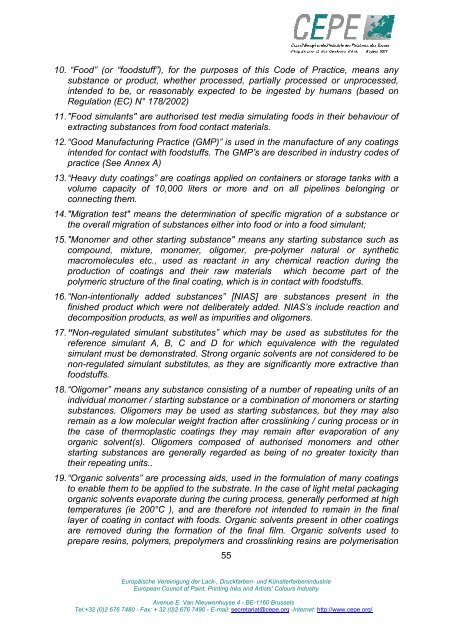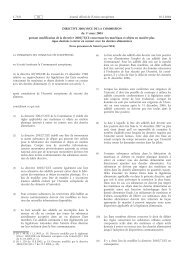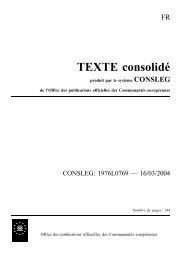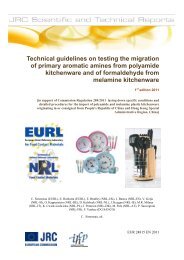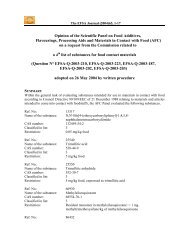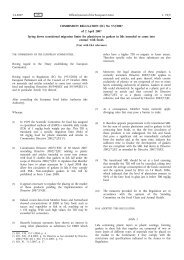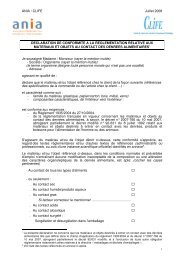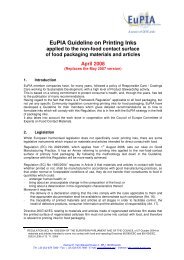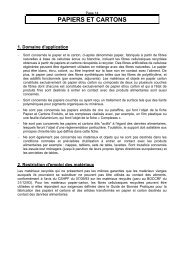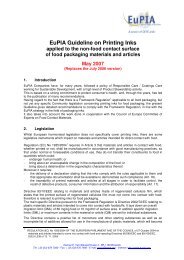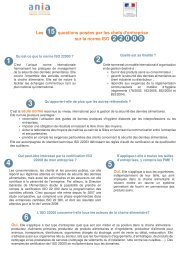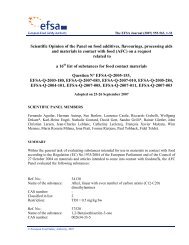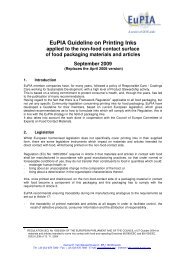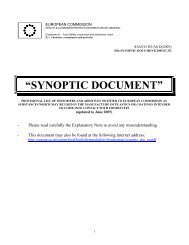WORKING DOCUMENT - Contact alimentaire
WORKING DOCUMENT - Contact alimentaire
WORKING DOCUMENT - Contact alimentaire
- No tags were found...
You also want an ePaper? Increase the reach of your titles
YUMPU automatically turns print PDFs into web optimized ePapers that Google loves.
10. “Food” (or “foodstuff”), for the purposes of this Code of Practice, means anysubstance or product, whether processed, partially processed or unprocessed,intended to be, or reasonably expected to be ingested by humans (based onRegulation (EC) N° 178/2002)11. "Food simulants" are authorised test media simulating foods in their behaviour ofextracting substances from food contact materials.12. “Good Manufacturing Practice (GMP)” is used in the manufacture of any coatingsintended for contact with foodstuffs. The GMP’s are described in industry codes ofpractice (See Annex A)13. “Heavy duty coatings” are coatings applied on containers or storage tanks with avolume capacity of 10,000 liters or more and on all pipelines belonging orconnecting them.14. "Migration test" means the determination of specific migration of a substance orthe overall migration of substances either into food or into a food simulant;15. "Monomer and other starting substance" means any starting substance such ascompound, mixture, monomer, oligomer, pre-polymer natural or syntheticmacromolecules etc., used as reactant in any chemical reaction during theproduction of coatings and their raw materials which become part of thepolymeric structure of the final coating, which is in contact with foodstuffs.16. “Non-intentionally added substances” [NIAS] are substances present in thefinished product which were not deliberately added. NIAS’s include reaction anddecomposition products, as well as impurities and oligomers.17. “Non-regulated simulant substitutes” which may be used as substitutes for thereference simulant A, B, C and D for which equivalence with the regulatedsimulant must be demonstrated. Strong organic solvents are not considered to benon-regulated simulant substitutes, as they are significantly more extractive thanfoodstuffs.18. “Oligomer” means any substance consisting of a number of repeating units of anindividual monomer / starting substance or a combination of monomers or startingsubstances. Oligomers may be used as starting substances, but they may alsoremain as a low molecular weight fraction after crosslinking / curing process or inthe case of thermoplastic coatings they may remain after evaporation of anyorganic solvent(s). Oligomers composed of authorised monomers and otherstarting substances are generally regarded as being of no greater toxicity thantheir repeating units..19. “Organic solvents” are processing aids, used in the formulation of many coatingsto enable them to be applied to the substrate. In the case of light metal packagingorganic solvents evaporate during the curing process, generally performed at hightemperatures (ie 200°C ), and are therefore not intended to remain in the finallayer of coating in contact with foods. Organic solvents present in other coatingsare removed during the formation of the final film. Organic solvents used toprepare resins, polymers, prepolymers and crosslinking resins are polymerisation55Europäische Vereinigung der Lack-, Druckfarben- und KünstlerfarbenindustrieEuropean Council of Paint, Printing Inks and Artists' Colours IndustryAvenue E. Van Nieuwenhuyse 4 - BE-1160 BrusselsTel:+32 (0)2 676 7480 - Fax: + 32 (0)2 676 7490 - E-mail: secretariat@cepe.org -Internet: http://www.cepe.org/


